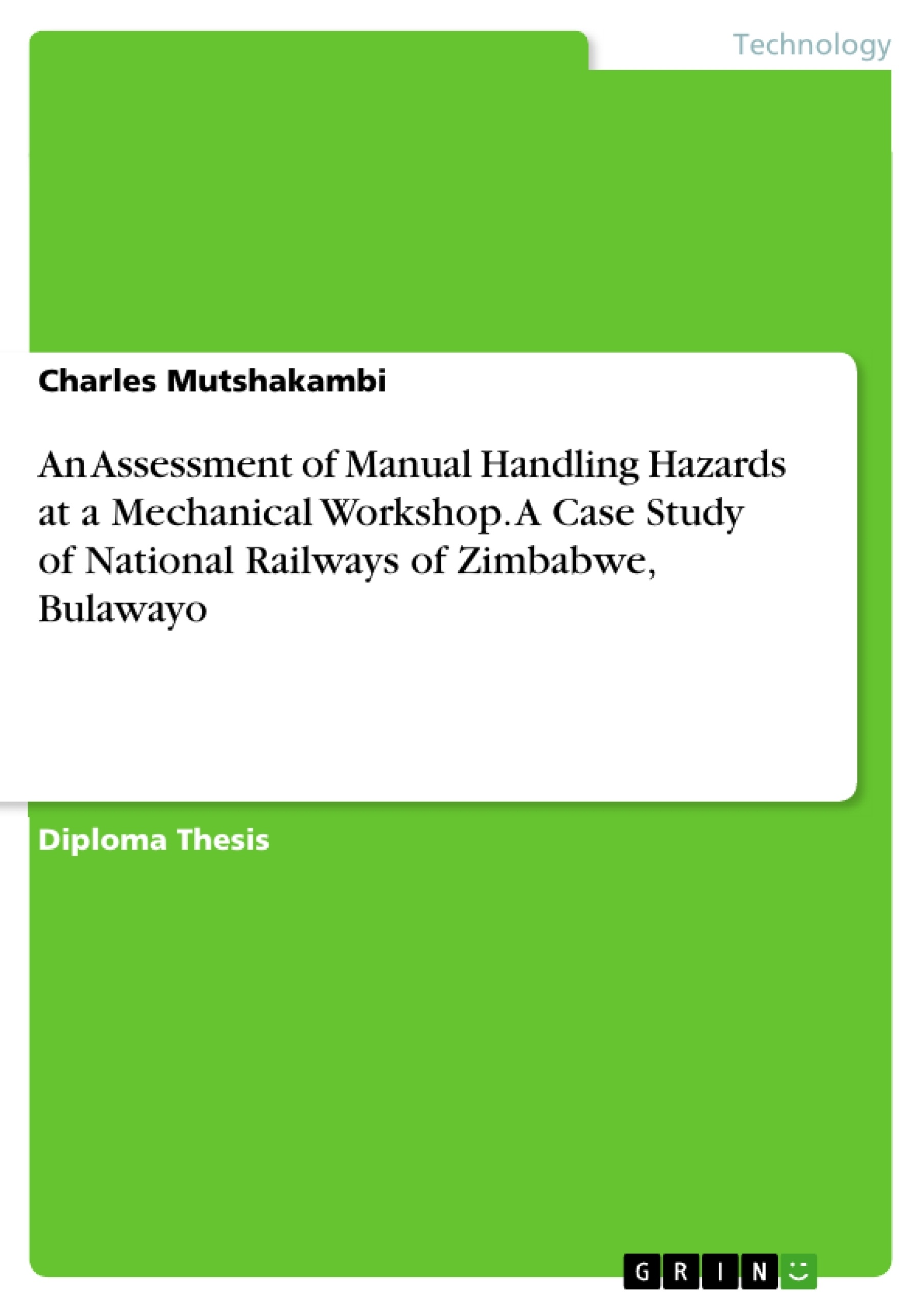This study assessed the manual handling hazards at the NRZ mechanical workshop in Bulawayo. The objectives of the research were the identification of MH hazards, determine the level of awareness of workers on manual handling issues and assessment of the control measures put in place at the organisation to deal with manual handling issues. The researcher adopted a case study research design while incorporating both qualitative and quantitative approaches. Five workshops were only selected namely Wagon, Fitting, Machine, Foundry and Carriage resulting in a sample of 153 questionnaire respondents which were distributed in a randomly. Key informants who were interviewed was the SHE practitioner, nurse in charge, and workshop foremen. More data was also gathered from relevant secondary data sources as well as from field observations. The Statistical Package for Social Sciences (SPSS) was used to analyse data and specifically using the Chi-Square test to establish correlations. The result indicated that the majority of the respondents are not aware of manual handling as revealed by the 73% of the respondents who indicated that they are not aware of manual handling. A number of manual handling hazards were identified which comprise of awkward postures, repetitive movements and vibration exposure which result in a number of injuries which are known as musculoskeletal disorders which encompass cuts muscle strain, sprains chronic pain and minor injuries, The research also noted that the measures which are put in place by management in dealing with manual handling are not effective as they lack strategic action thereby limiting the success of the measures. It was finally concluded that there is need to consider ergonomic interventions in the day to day operations of the company in order to reduce work related risk factors and injuries which come as a result of manual handling. Recommendations were also forwarded to the nation and company on how to address manual handling issues.
TABLE OF CONTENTS
ACKNOWLEDGEMENTS
ABSTRACT
TABLE OF CONTENTS
List of figures
List of Tables
ACRONYMS
CHAPTER ONE: INTRODUCTION
1.1 Introduction
1.2 Statement of the problem
1.3 Objectives
1.3.1 General objective
1.3.2 Specific objective
1.4 Justification of the study
1.5 Scope of the study
1.6 Limitations of the study
1.7 Chapter summary
CHAPTER TWO: LITERATURE REVIEW
2.2 Conceptual framework
2.2 Trends of occupational accidents and injuries in Zimbabwe
2.3 Overview of manual handling
2.4 Manual handling Risk factors
2.5 Effects of manual handling
2.7 Management of manual handling hazards
2.7.1 Hazard identification
2.7.2 Engineering Controls
2.7.3 Administrative controls.
2.7.4 Personal protective equipment’s/ Clothes
2.8 Influence of manual handling training and awareness to employees
2.9 Knowledge gap
2.10 Chapter Summary
CHAPTER THREE: RESEARCH METHODOLOGY
3.1. Introduction
3.2 Research Design
3.3 Target Population
3.4 Sample Size Determination
3.5 Methods of Data Collection
3.5.1 Questionnaires
3.5.2 Interviews
3.5.3 Field Observations
3.5.4 Secondary Data
3.6 Data analysis and presentation
3.7 Ethical considerations
3.8 Reliability and Validity
3.9 Chapter summary
CHAPTER FOUR: RESULTS AND DISCUSSIONS
4.1 Introduction
4.2 Demographic characteristics of respondents
4.2.1 Response rate
4.2.2 Gender of respondents
4.2.3 Age of Respondents
4.2.4 Level of Education
4.2.5 Work experience
4.3 Manual Handling hazards
4.3.1 Forceful exertion/ efforts
4.3.2 Unstable loads
4.3.3 Vibration exposure
4.3.4 Repetitive movements
4.3.5 Awkward postures
4.4 Effects of Manual handling hazards
4.4.1 Manual Handling related injuries on a five years period
4.5 Level of awareness of workers on MH hazards
4.5.1 Respondents knowledge on MH
4.5.2 Awareness level of MH hazards.
4.6 Manual Handling control measures
4.6.1 Safe operating procedures and training
4.6.2 Safety Audits
4.6.3 Personal protective clothing / equipment
4.6.4 Legal framework guiding manual handling
4.6.5 Responses on evaluating control measures
4.7 Chapter summary
CHAPTER FIVE: CONCLUSION AND RECOMMENDATIONS
5.1 Conclusion
5.2 Recommendations
5.3 Chapter Summary
Reference List
Appendices
- Arbeit zitieren
- Charles Mutshakambi (Autor:in), 2019, An Assessment of Manual Handling Hazards at a Mechanical Workshop. A Case Study of National Railways of Zimbabwe, Bulawayo, München, GRIN Verlag, https://www.grin.com/document/511330
-

-

-

-
Laden Sie Ihre eigenen Arbeiten hoch! Geld verdienen und iPhone X gewinnen. -

-
Laden Sie Ihre eigenen Arbeiten hoch! Geld verdienen und iPhone X gewinnen. -

-
Laden Sie Ihre eigenen Arbeiten hoch! Geld verdienen und iPhone X gewinnen. -

-
Laden Sie Ihre eigenen Arbeiten hoch! Geld verdienen und iPhone X gewinnen. -

-
Laden Sie Ihre eigenen Arbeiten hoch! Geld verdienen und iPhone X gewinnen. -

-
Laden Sie Ihre eigenen Arbeiten hoch! Geld verdienen und iPhone X gewinnen. -

-
Laden Sie Ihre eigenen Arbeiten hoch! Geld verdienen und iPhone X gewinnen. -

-
Laden Sie Ihre eigenen Arbeiten hoch! Geld verdienen und iPhone X gewinnen. -

-
Laden Sie Ihre eigenen Arbeiten hoch! Geld verdienen und iPhone X gewinnen. -

-
Laden Sie Ihre eigenen Arbeiten hoch! Geld verdienen und iPhone X gewinnen. -

-
Laden Sie Ihre eigenen Arbeiten hoch! Geld verdienen und iPhone X gewinnen. -

-
Laden Sie Ihre eigenen Arbeiten hoch! Geld verdienen und iPhone X gewinnen.

